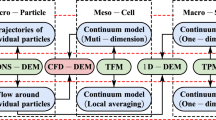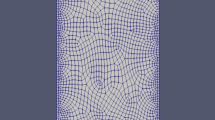Abstract
Laminar dimethyl ether (DME) coflow jet flames, defined by different levels of partial premixing in the fuel stream, provide canonical test cases for studying conditions in between perfectly premixed and non-premixed characteristics. This work investigates the structure of DME/air flames and the evaluation of suitable flamelet modeling approaches. Three laminar, partially premixed DME/air flames are studied using fully resolved numerical simulations and the flamelet/progress variable (FPV) approach. The flame structure of the partially premixed DME/air flames is discussed and selected slices are compared to each other as well as to Raman/Rayleigh data. Overall, the experimental data is well predicted and the local flame structure is represented by the fully resolved simulations. In the context of the FPV approach, an a priori analysis of the underlying tabulated manifold is carried out. Lookup tables based on strained counterflow flames were identified as the most suitable candidate for the fully coupled FPV simulations of all three partially premixed DME/air flames. The FPV results are further compared a posteriori to the fully resolved simulation data. The flame structure of the partially premixed DME/air flames was reproduced and good results were obtained for the temperature and the species mass fractions. This numerical investigation contributes to the understanding of local flame structures in partially premixed DME/air flames and has the potential to support model selection in complex combustion processes.







Similar content being viewed by others
Notes
\(X_{\text {HC}}=X_{\text {CH}_{3}\text {OCH}_{3}}+X_{\text {CH}_{4}}+X_{\text {CH}_{3}}+X_{\text {C}_{2}\text {H}_{4}}+X_{\text {C}_{2}\text {H}_{6}}\).
\(c=\frac {\left (Y_{c}-\min (Y_{c})\right )}{\left (\max (Y_{c})-\min (Y_{c})\right )}\).
Calculated according to [37].
Note that the fuel composition in Eq. 7 corresponds to the partially premixed DME/air inlet mixtures of L1, L3 and L2, respectively.
References
Fleisch, T., Basu, A., Sills, R.: Introduction and advancement of a new clean global fuel: The status of DME developments in china and beyond. J. Nat. Gas. Sci. Eng. 9, 94–107 (2012). https://doi.org/10.1016/j.jngse.2012.05.012. http://www.sciencedirect.com/science/article/pii/S1875510012000650
International workshop on measurement and computation of turbulent flames, http://www.sandia.gov/TNF/abstract.html (2014)
Fuest, F., Barlow, R.S., Chen, J.Y., Dreizler, A.: Raman/Rayleigh scattering and CO-LIF measurements in laminar and turbulent jet flames of dimethyl ether. Combust. Flame 159(8), 2533–2562 (2012). https://doi.org/10.1016/j.combustflame.2011.11.001. http://www.sciencedirect.com/science/article/pii/S0010218011003488
Bhagatwala, A., Luo, Z., Shen, H., Sutton, J.A., Lu, T., Chen, J.H.: Numerical and experimental investigation of turbulent dme jet flames. Proc. Combust. Inst. 35(2), 1157–1166 (2015). https://doi.org/10.1016/j.proci.2014.05.147. http://www.sciencedirect.com/science/article/pii/S1540748914001503
Coriton, B., Im, S.K., Gamba, M., Frank, J.: Flow field and scalar measurements in a series of turbulent partially-premixed dimethyl ether/air jet flames. Combust. Flame 180, 40–52 (2017). https://doi.org/10.1016/j.combustflame.2017.02.014
Fuest, F., Barlow, R.S., Magnotti, G., Dreizler, A., Ekoto, I.W., Sutton, J.A.: Quantitative acetylene measurements in laminar and turbulent flames using 1D Raman/Rayleigh scattering. Combust. Flame 162(5), 2248–2255 (2015). https://doi.org/10.1016/j.combustflame.2015.01.021. http://www.sciencedirect.com/science/article/pii/S0010218015000334
Fuest, F., Barlow, R.S., Magnotti, G., Sutton, J.A.: Scalar dissipation rates in a turbulent partially-premixed dimethyl ether/air jet flame. Combust. Flame 188, 41–65 (2018). https://doi.org/10.1016/j.combustflame.2017.09.020. http://www.sciencedirect.com/science/article/pii/S0010218017303516
Gabet, K.N., Shen, H., Patton, R.A., Fuest, F., Sutton, J.A.: A comparison of turbulent dimethyl ether and methane non-premixed flame structure. Proc. Combust. Inst. 34(1), 1447–1454 (2013). https://doi.org/10.1016/j.proci.2012.06.183. http://www.sciencedirect.com/science/article/pii/S154074891200291X
Hampp, F., Lindstedt, R.: Quantification of combustion regime transitions in premixed turbulent dme flames. Combust. Flame 182, 248–268 (2017). https://doi.org/10.1016/j.combustflame.2017.04.006. http://www.sciencedirect.com/science/article/pii/S0010218017301335
Coriton, B., Zendehdel, M., Ukai, S., Kronenburg, A., Stein, O.T., Im, S.K., Gamba, M., Frank, J.H.: Imaging measurements and LES-CMC modeling of a partially-premixed turbulent dimethyl ether/air jet flame. Proc. Combust. Inst. 35(2), 1251–1258 (2015). https://doi.org/10.1016/j.proci.2014.06.042. http://www.sciencedirect.com/science/article/pii/S1540748914002004
Kronenburg, A., Stein, O.: LES-CMC of a partially premixed, turbulent dimethyl ether jet diffusion flame. Flow. Turb. Combust. 98(3), 803–816 (2017). https://doi.org/10.1007/s10494-016-9788-4
Minamoto, Y., Chen, J.H.: DNS of a turbulent lifted DME jet flame. Combust Flame 169, 38–50 (2016). https://doi.org/10.1016/j.combustflame.2016.04.007. http://www.sciencedirect.com/science/article/pii/S0010218016300542
Popp, S., Hunger, F., Hartl, S., Messig, D., Coriton, B., Frank, J.H., Fuest, F., Hasse, C.: LES flamelet-progress variable modeling and measurements of a turbulent partially-premixed dimethyl ether jet flame. Combust. Flame 162(8), 3016–3029 (2015). https://doi.org/10.1016/j.combustflame.2015.05.004. http://www.sciencedirect.com/science/article/pii/S001021801500142X
You, J., Yang, Y., Pope, S.B.: Effects of molecular transport in LES/PDF of piloted turbulent dimethyl ether/air jet flames. Combust. Flame 176, 451–461 (2017). https://doi.org/10.1016/j.combustflame.2016.11.007. http://www.sciencedirect.com/science/article/pii/S0010218016303479
Knudsen, E., Pitsch, H.: A general flamelet transformation useful for distinguishing between premixed and non-premixed modes of combustion. Combust. Flame 156(3), 678–696 (2009). https://doi.org/10.1016/j.combustflame.2008.10.021. http://www.sciencedirect.com/science/article/pii/S0010218008003246
Knudsen, E., Pitsch, H.: Capabilities and limitations of multi-regime flamelet combustion models. Combust. Flame 159(1), 242–264 (2012). https://doi.org/10.1016/j.combustflame.2011.05.025. http://www.sciencedirect.com/science/article/pii/S0010218011001982
Wu, H., See, Y.C., Wang, Q., Ihme, M.: A pareto-efficient combustion framework with submodel assignment for predicting complex flame configurations. Combust. Flame 162(11), 4208–4230 (2015). https://doi.org/10.1016/j.combustflame.2015.06.021. http://www.sciencedirect.com/science/article/pii/S0010218015002564
Hartl, S., Geyer, D., Dreizler, A., Magnotti, G., Barlow, R.S., Hasse, C.: Regime identification from Raman/Rayleigh line measurements in partially premixed flames. Combust. Flame 189, 126–141 (2018). https://doi.org/10.1016/j.combustflame.2017.10.024. https://www.sciencedirect.com/science/article/pii/S0010218017304212
Pierce, C.D., Moin, P.: Progress-variable approach for large-eddy simulation of non-premixed turbulent combustion. J. Fluid Mech. 504, 73–97 (2004). https://doi.org/10.1017/S0022112004008213
Domingo, P., Vervisch, L., Réveillon, J.: DNS analysis of partially premixed combustion in spray and gaseous turbulent flame-bases stabilized in hot air. Combust. Flame 140(3), 172–195 (2005). https://doi.org/10.1016/j.combustflame.2004.11.006. http://www.sciencedirect.com/science/article/pii/S0010218004002342
Ihme, M., See, Y.C.: Prediction of autoignition in a lifted methane/air flame using an unsteady flamelet/progress variable model. Combust. Flame 157(10), 1850–1862 (2010). https://doi.org/10.1016/j.combustflame.2010.07.015
See, Y.C., Ihme, M.: Large eddy simulation of a partially-premixed gas turbine model combustor. Proc. Combust. Inst. 35(2), 1225–1234 (2015). https://doi.org/10.1016/j.proci.2014.08.006. http://www.sciencedirect.com/science/article/pii/S1540748914003903
Vreman, A., Albrecht, B., van Oijen, J., de Goey, L., Bastiaans, R.: Premixed and nonpremixed generated manifolds in large-eddy simulation of Sandia flame D and F. Combust. Flame 153(3), 394–416 (2008). https://doi.org/10.1016/j.combustflame.2008.01.009. http://www.sciencedirect.com/science/article/pii/S0010218008000667
Garten, B., Hunger, F., Messig, D., Stelzner, B., Trimis, D., Hasse, C.: Detailed radiation modeling of a partial-oxidation flame. IJTS 87, 68–84 (2015). https://doi.org/10.1016/j.ijthermalsci.2014.07.022. http://www.sciencedirect.com/science/article/pii/S1290072914002385
Hunger, F., Zulkifli, M.F., Williams, B.A.O., Beyrau, F., Hasse, C.: A combined experimental and numerical study of laminar and turbulent non-piloted oxy-fuel jet flames using a direct comparison of the rayleigh signal. Flow. Turb. Combust. 97(1), 231–262 (2016). https://doi.org/10.1007/s10494-015-9681-6
Messig, D., Hunger, F., Keller, J., Hasse, C.: Evaluation of radiation modeling approaches for non-premixed flamelets considering a laminar methane air flame. Combust. Flame 160(2), 251–264 (2013). https://doi.org/10.1016/j.combustflame.2012.10.009. http://www.sciencedirect.com/science/article/pii/S0010218012002970
Zhao, Z., Chaos, M., Kazakov, A., Dryer, F.L.: Thermal decomposition reaction and a comprehensive kinetic model of dimethyl ether. IJCK 40(1), 1–18 (2008). https://doi.org/10.1002/kin.20285
Barlow, R., Meares, S., Magnotti, G., Cutcher, H., Masri, A.: Local extinction and near-field structure in piloted turbulent CH4/air jet flames with inhomogeneous inlets. Combust. Flame 162(10), 3516–3540 (2015). https://doi.org/10.1016/j.combustame.2015.06.009. http://www.sciencedirect.com/science/article/pii/S001021801500190X
Barlow, R.S., Dunn, M.J., Sweeney, M.S., Hochgreb, S.: Effects of preferential transport in turbulent bluff-body-stabilized lean premixed CH4/air flames. Combust. Flame 159(8), 2563–2575 (2012). https://doi.org/10.1016/j.combustflame.2011.11.013. http://www.sciencedirect.com/science/article/pii/S0010218011003877
Magnotti, G., Barlow, R.S.: Effects of high shear on the structure and thickness of turbulent premixed methane/air flames stabilized on a bluff-body burner. Combust. Flame 162(1), 100–114 (2015). https://doi.org/10.1016/j.combustflame.2014.06.015. http://www.sciencedirect.com/science/article/pii/S001021801400193X
Poinsot, T., Veynante, D.: Theoretical and numerical combustion (2012)
Pitsch, H., Peters, N.: A consistent flamelet formulation for non-premixed combustion considering differential diffusion effects. Combust. Flame 114(1-2), 26–40 (1998). https://doi.org/10.1016/S0010-2180(97)00278-2. http://www.sciencedirect.com/science/article/pii/S0010218097002782
Hasse, C.: A Two-Dimensional Flamelet Model for Multiple Injections in Diesel Engines. Ph.D. thesis, RWTH Aachen (2004)
Peters, N.: Laminar diffusion flamelet models in non-premixed turbulent combustion. Prog. Energy Combust. Sci. 10(3), 319–339 (1984)
Fiorina, B., Mercier, R., Kuenne, G., Ketelheun, A., Avdi, A., Janicka, J., Geyer, D., Dreizler, A., Alenius, E., Duwig, C., Trisjono, P., Kleinheinz, K., Kang, S., Pitsch, H., Proch, F., Marincola, F.C., Kempf, A.: Challenging modeling strategies for LES of non-adiabatic turbulent stratified combustion. Combust. Flame 162(11), 4264–4282 (2015). https://doi.org/10.1016/j.combustflame.2015.07.036. http://www.sciencedirect.com/science/article/pii/S0010218015002370
Kee, R.J., Miller, J.A., Evans, G.H., Dixon-Lewis, G.: A computational model of the structure and extinction of strained, opposed flow, premixed methane-air flames. Proc. Combust. Inst. 22(1), 1479–1494 (1989). https://doi.org/10.1016/S0082-0784(89)80158-4. http://www.sciencedirect.com/science/article/pii/S0082078489801584
Verhoeven, L., Ramaekers, W., van Oijen, J., de Goey, L.: Modeling non-premixed laminar co-flow flames using flamelet-generated manifolds. Combustion and Flame 159(1), 230–241 (2012). https://doi.org/10.1016/j.combustflame.2011.07.011. http://www.sciencedirect.com/science/article/pii/S0010218011002239
Oijen, J.V., Goey, L.D.: Modelling of premixed laminar flames using flamelet-generated manifolds. Combust. Sci. Technol. 161 (1), 113–137 (2000). https://doi.org/10.1080/00102200008935814. http://www.tandfonline.com/doi/abs/10.1080/00102200008935814
Gicquel, O., Darabiha, N., Thévenin, D.: Laminar premixed hydrogen/air counterflow flame simulations using flame prolongation of ILDM with differential diffusion. Proc. Combust. Inst. 28(2), 1901–1908 (2000). https://doi.org/10.1016/S0082-0784(00)80594-9. http://www.sciencedirect.com/science/article/pii/S0082078400805949
Bilger, R., Sterner, S., Kee, R.: On reduced mechanisms for methane air combustion in nonpremixed flames. Combust. Flame 80(2), 135–149 (1990). https://doi.org/10.1016/0010-2180(90)90122-8. http://www.sciencedirect.com/science/article/pii/0010218090901228
Lu, T., Yoo, C., Chen, J., Law, C.: Three-dimensional direct numerical simulation of a turbulent lifted hydrogen jet flame in heated coflow: a chemical explosive mode analysis. J. Fluid Mech. 652, 45–64 (2010). https://doi.org/10.1017/S002211201000039X
Shan, R., Yoo, C.S., Chen, J.H., Lu, T.: Computational diagnostics for n-heptane flames with chemical explosive mode analysis. Combust. Flame 159(10), 3119–3127 (2012). https://doi.org/10.1016/j.combustflame.2012.05.012. http://www.sciencedirect.com/science/article/pii/S0010218012001770
Dodoulas, I.A., Navarro-Martinez, S.: Analysis of extinction in a non-premixed turbulent flame using large eddy simulation and the chemical explosion mode analysis. Combust. Theor. Model. 19(1), 107–129 (2015). https://doi.org/10.1080/13647830.2014.993713
Lyra, S., Wilde, B., Kolla, H., Seitzman, J.M., Lieuwen, T.C., Chen, J.H.: Structure of hydrogen-rich transverse jets in a vitiated turbulent flow. Combust. Flame 162(4), 1234–1248 (2015). https://doi.org/10.1016/j.combustflame.2014.10.014. http://www.sciencedirect.com/science/article/pii/S0010218014003356
Domingo, P., Vervisch, L., Bray, K.: Partially premixed flamelets in LES of nonpremixed turbulent combustion. Combust. Theor. Model. 6(4), 529–551 (2002). https://doi.org/10.1088/1364-7830/6/4/301
Lamouroux, J., Ihme, M., Fiorina, B., Gicquel, O.: Tabulated chemistry approach for diluted combustion regimes with internal recirculation and heat losses. Combustion and Flame 161 (8), 2120–2136 (2014). https://doi.org/10.1016/j.combustflame.2014.01.015. http://www.sciencedirect.com/science/article/pii/S0010218014000200
Yamashita, H., Shimada, M., Takeno, T.: A numerical study on flame stability at the transition point of jet diffusion flames. Proc. Combust. Inst. 26(1), 27–34 (1996). https://doi.org/10.1016/S0082-0784(96)80196-2. http://www.sciencedirect.com/science/article/pii/S0082078496801962
Daly, C.A., Simmie, J.M., Wuermel, J., Djeballi, N., Paillard, C.: Burning velocities of dimethyl ether and air. Combust. Flame 125(4), 1329–1340 (2001). https://doi.org/10.1016/S0010-2180(01)00249-8. http://www.sciencedirect.com/science/article/pii/S0010218001002498
Acknowledgments
The authors kindly acknowledge the financial support by the Federal Ministry of Food and Agriculture (project number 22008613). C. Hasse and S. Hartl acknowledge support by the German Research Foundation in the collaborative project “Multi Regime combustion under technically relevant conditions” (grant numbers HA 4367/5-1).
Author information
Authors and Affiliations
Corresponding author
Ethics declarations
Conflict of interests
The authors declare that they have no conflict of interest.
Additional information
Publisher’s Note
Springer Nature remains neutral with regard to jurisdictional claims in published maps and institutional affiliations.
Rights and permissions
About this article
Cite this article
Hartl, S., Messig, D., Fuest, F. et al. Flame Structure Analysis and Flamelet/Progress Variable Modelling of DME/Air Flames with Different Degrees of Premixing. Flow Turbulence Combust 102, 757–773 (2019). https://doi.org/10.1007/s10494-018-9981-8
Received:
Accepted:
Published:
Issue Date:
DOI: https://doi.org/10.1007/s10494-018-9981-8




